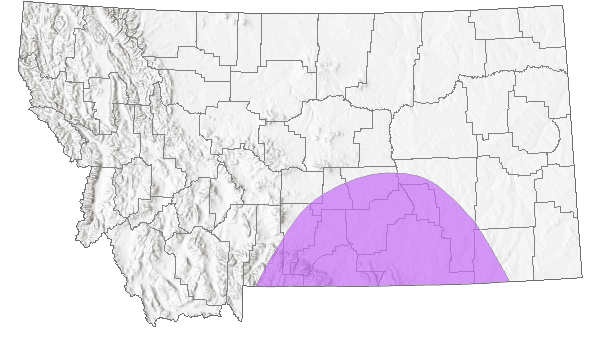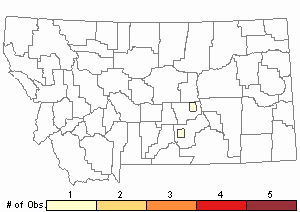View in other NatureServe Network Field Guides
NatureServe
Montana
Utah
Wyoming
Idaho
Wisconsin
British Columbia
South Carolina
Yukon
California
New York
Masked Grasshopper - Trimerotropis cincta
General Description
The following is taken from Helfer (1971), Capinera and Sechrist (1982), Otte (1984), Vickery and Kevan (1985), Richman et al. (1993), Brust et al. (2008), and Scott (2010). This species almost always has a black band crossing the lateral side of the face below the eye from the thorax to the front, and a short black band above the antennal sockets (these features separate it from T. fontanus). Two to three distinct crossbands occur on the tegmina (forewings) and rarely cross the dorsal surface, which is distinctly lighter than the lateral surface. The disk of the hindwings is yellow, pale yellow, or greenish yellow with a narrow, faded black band and fairly long spur. The outer face of the hind femur is marked with 2 dark angular crossbands and dark apex. The inner face is pale with 3 black crossbands at the median area and knee. The hind tibia can be blue, gray, yellowish gray with a black marking at its base, it is never red.
Communicative behavior/Crepitation*
Solitary males crepitate emitting one to several bursts of irregular duration. They circle over a general area, flying up to 50 feet before landing. Females do not crepitate. During courtship, males employ both silent femur-shaking and stridulation*. Sometimes only femur-tipping occurs, but is the display used in male-to-male aggressive encounters (Otte 1970, and Vickery and Kevan 1985).
*Crepitation is the sound produced by grasshoppers making a clicking or snapping noise with their wings when in flight, during courtship, territorial encounters or being disturbed.
*Stridulation is rubbing one body part against another, usually the hind femur against the forewing in the case of the Band-winged Grasshoppers. This is often used for attracting a female during courtship (Otte 1970).
Phenology
This species overwinters in the egg stage. Nymphs appear in June. Adults occur by the third week of July to early September, being most abundant in August (Otte 1984, and Vickery and Kevan 1985).
Diagnostic Characteristics
The following comes from Helfer (1971), Capinera and Sechrist (1982), Otte (1984), Vickery and Kevan (1985), Richman et al. (1993), Brust et al. (2008), and Scott (2010). The body length to end of forewings for males is 21-28 mm, for females 28-36 mm.
The Masked Grasshopper can be confused with almost any other
Trimerotropis species, especially
Pallid-winged Grasshopper (
T. pallidipennis). Always compare characteristics with other species described in this Field Guide and even refer to other sources listed in the References section.
Species Range
Montana Range
Range Descriptions

 Native
Native
Range Comments
This species occurs from southern British Columbia, southward to Arizona and New Mexico. From west to east, in Idaho, Utah, and northern Arizona, extending to the southwest corner of South Dakota and the northwest corner of Nebraska. In Montana, it has been reported for 3 southcentral counties (Otte 1970, Vickery and Kevan 1985, and Scott 2010).
Observations in Montana Natural Heritage Program Database
Number of Observations: 2
(Click on the following maps and charts to see full sized version)
Map Help and Descriptions
Relative Density

Recency


 (Observations spanning multiple months or years are excluded from time charts)
(Observations spanning multiple months or years are excluded from time charts)
Habitat
The Masked Grasshopper inhabits bare patches of ground of foothills grasslands with open pine woodlands and small clearings from 6,000 to 10,000 feet elevation, on volcanic sand, gravel, and rocky soils with sparse vegetation. This is primarily a montane species (Otte 1970, Capinera and Sechrist 1982).
Food Habits
Unknown
Reproductive Characteristics
Unknown
Stewardship Responsibility
References
- Literature Cited AboveLegend:
 View Online Publication
View Online Publication Brust, M.L, W.W. Hoback, and R.J. Wright. 2008. The Grasshoppers of Nebraska. Lincoln, NB: University of Nebraska Extension Service, APHIS.
Brust, M.L, W.W. Hoback, and R.J. Wright. 2008. The Grasshoppers of Nebraska. Lincoln, NB: University of Nebraska Extension Service, APHIS. Capinera, J.L. and T.S. Sechrist. 1982. Grasshoppers of Colorado: Identification, Biology, and Management. Fort Collins, CO: Colorado State University Experiment Station, Bulletin 584S. 161 p.
Capinera, J.L. and T.S. Sechrist. 1982. Grasshoppers of Colorado: Identification, Biology, and Management. Fort Collins, CO: Colorado State University Experiment Station, Bulletin 584S. 161 p. Helfer, J.R. 1971. How to Know the Grasshoppers, Crickets, Cockroaches, and Their Allies. Revised edition (out of print), Mineola, NY: Dover Publications.
Helfer, J.R. 1971. How to Know the Grasshoppers, Crickets, Cockroaches, and Their Allies. Revised edition (out of print), Mineola, NY: Dover Publications. Otte, Daniel. 1970. A comparative study of communicative behavior in grasshoppers. Miscellaneous Publications, Museum of Zoology, No. 141. Ann Arbor, MI: University of Michigan.
Otte, Daniel. 1970. A comparative study of communicative behavior in grasshoppers. Miscellaneous Publications, Museum of Zoology, No. 141. Ann Arbor, MI: University of Michigan. Otte, Daniel. 1984. The North American Grasshoppers Volume II. Acrididae (Oedipodinae). Harvard University Press. 366 pp.
Otte, Daniel. 1984. The North American Grasshoppers Volume II. Acrididae (Oedipodinae). Harvard University Press. 366 pp. Richman, D.B., D.C. Lightfoot, C.A. Sutherland, and D.J. Ferguson. 1993. A manual of the grasshoppers of New Mexico. Las Cruces, NM: Cooperative Extension Service, Handbook No. 7.
Richman, D.B., D.C. Lightfoot, C.A. Sutherland, and D.J. Ferguson. 1993. A manual of the grasshoppers of New Mexico. Las Cruces, NM: Cooperative Extension Service, Handbook No. 7. Scott, R.D. 2010. Montana Grasshoppers, Katydids, and Crickets A Pictorial Field Guide to the Orthoptera. MagpieMTGraphics, Billings, MT.
Scott, R.D. 2010. Montana Grasshoppers, Katydids, and Crickets A Pictorial Field Guide to the Orthoptera. MagpieMTGraphics, Billings, MT. Vickery, V. R. and D. K. M. Kevan. 1985. The grasshopper, crickets, and related insects of Canada and adjacent regions. Biosystematics Research Institute, Ottawa, Ontario. Publication Number 1777. 918 pp.
Vickery, V. R. and D. K. M. Kevan. 1985. The grasshopper, crickets, and related insects of Canada and adjacent regions. Biosystematics Research Institute, Ottawa, Ontario. Publication Number 1777. 918 pp.
- Additional ReferencesLegend:
 View Online Publication
View Online Publication
Do you know of a citation we're missing? Anderson, N.L. 1962. Grasshopper-vegetation relationships on Montana grasslands. Ph.D Dissertation. Bozeman, Montana: Montana State University. 73 p.
Anderson, N.L. 1962. Grasshopper-vegetation relationships on Montana grasslands. Ph.D Dissertation. Bozeman, Montana: Montana State University. 73 p. Capinera, J.L., R.D. Scott, and T.J. Walker. 2004. Field Guide to Grasshoppers, Katydids, and Crickets of the United States. Ithaca, NY. Cornell University Press.
Capinera, J.L., R.D. Scott, and T.J. Walker. 2004. Field Guide to Grasshoppers, Katydids, and Crickets of the United States. Ithaca, NY. Cornell University Press. Hebard, M. 1928. The Orthoptera of Montana. Proceedings of the Academy of Natural Sciences of Philadelphia, Vol. 80:211-306.
Hebard, M. 1928. The Orthoptera of Montana. Proceedings of the Academy of Natural Sciences of Philadelphia, Vol. 80:211-306.
- Web Search Engines for Articles on "Masked Grasshopper"
- Additional Sources of Information Related to "Insects"





